How to Do Lunges Correctly
Whether you’re looking to build muscle or just increase mobility, learning how to do lunges properly is important. The basic lower-body movement is likely one that you do on a daily basis without evening thinking every time you climb a flight of stairs, or kneel down to pick something up.
Lunges are a type of unilateral movement—meaning that you use each side of your body independently. Another unilateral movement you do all the time? Walking. Unilateral movements are important because they can help improve balance and they help to ensure you’re building muscle evenly on both sides of your body. Unilateral movements are in contrast to bilateral movements, where both sides of the body work together at the same time. Think: squats, bench presses, or push-ups. You need both types of movement if you’re looking to create a solid working program—and learning how to do lunges can help fill in one part of that equation.
What Is a Lunge
A lunge is probably one of the first exercises you might learn to do in a gym or studio class. Lunges primarily work the muscles in your lower body, but if done correctly, they should also work your core and even help strengthen your back and shoulders through proper posture. While many people think doing lunges might cause knee pain, if you’ve learned how to do lunges correctly, they shouldn’t put additional strain on your joints.
Lunges recruit several big muscle groups in your lower body, including your glutes, hamstrings (the muscles on the back of your legs), hips, and core; they also work your calves and quads (the muscles on the front of your legs).
Depending on your hip mobility and any pre-existing knee pain, you may find certain lunges (like lateral lunges or stationary lunges) to be more comfortable for your body. The good news is that there are so many lunge variations, it’s easy to find one that works well for you.
Benefits of Lunges
Lunges have several benefits, including strengthening many of the major muscle groups in your lower body. You can build muscle in your glutes, quads, hamstrings, and calves by doing lunges regularly.
You can also strengthen your core by keeping your abs engaged throughout the movement. Lunges can also help increase your balance as you step forward and backward, and they can help correct muscle imbalances, since they force you to work each side of your body separately.
Lunge Technique
The most classic lunge you can do is a forward lunge. Directions for lunge variations can be found under “Types of Lunges” in the next section, but here’s a detailed breakdown of forward lunge technique:
From a standing position, step your right foot 2 to 3 feet ahead of your left foot and stagger so your feet are not directly in front of one another. (Think about standing your feet on opposite railroad tracks, rather than walking a tightrope.)
Engage your core and tuck your hips so that your low back is not arched and your pelvis is inline with your rib cage.
Breathing in, bend both knees to 90 degrees until your right thigh is parallel to the floor. Your hands can rest on your hips to help ensure your hips stay straight and don’t tip forward or back.
At the bottom of your lunge, your right shin should be almost perpendicular to the floor, your right foot flat on the floor, and you should rest on your left toes (left heel elevated off the floor).
Return to your starting position by exhaling as you push through both feet and squeeze your glutes to stand.
You should practice to make your lunge technique precise and fluid before adding weight by holding dumbbells or a barbell.
Types of Lunges
If you’re just getting started with lunges or if doing lunges hurts your knees, you may find that stationary lunges (also called static lunges or split squats) or alternating reverse lunges are easier (details on both of those below). Both of those lunges will put less stress on your knees and also require less balance than a forward lunge or walking lunge.
You can also try lateral lunges, which will help to work your hip abductors (the muscles on the outside of your hip), glutes, and hamstrings—all while putting a little less pressure on your knees since you’ll be stepping out to the side instead of forward or backwards.
If you’re looking for a challenge, you can add weight to almost any of the moves listed below by holding a single dumbbell or kettlebell at chest height, or a dumbbell in each hand.
Forward Lunge
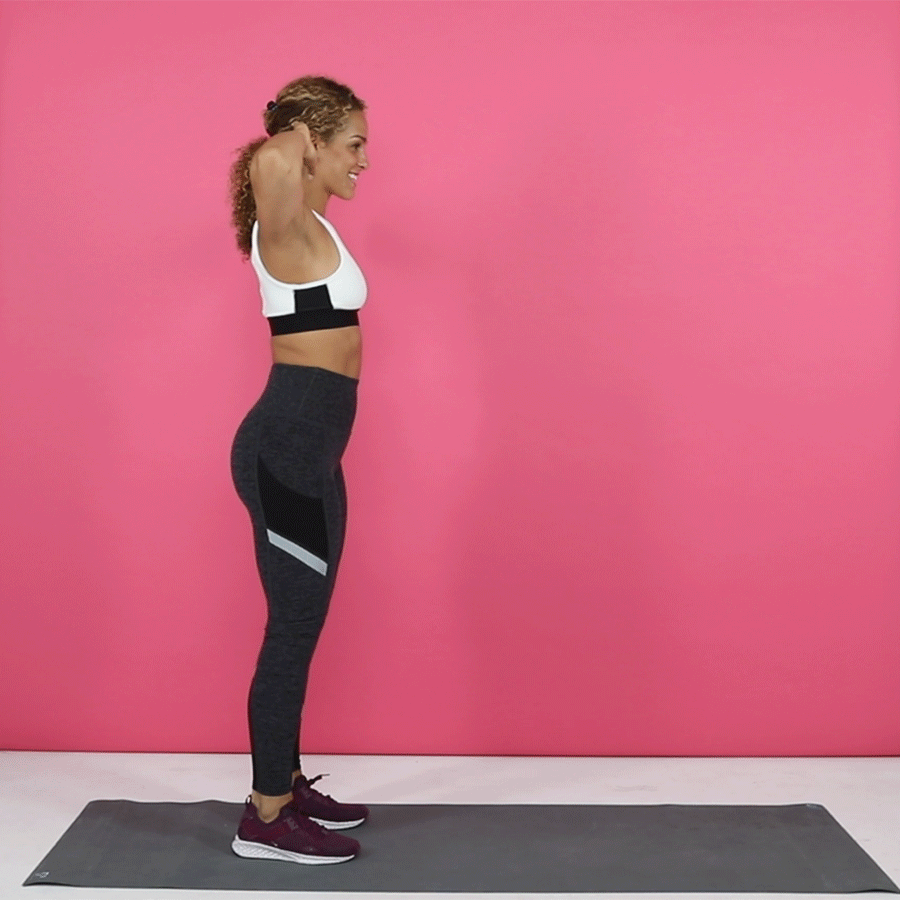
Stand with your feet hip-width apart and core engaged.
Step forward with your right foot and bend both knees to 90 degrees to sink into a lunge. Your right thigh should be parallel to the floor. Keep your core engaged and hips tucked as you bend your knees, ensuring your low back does not arch.
Push off right foot and engage your left glutes to return to starting position.
You can either repeat all reps on the same side, or alternate sides by stepping forward with the left foot next time.
Reverse Lunge
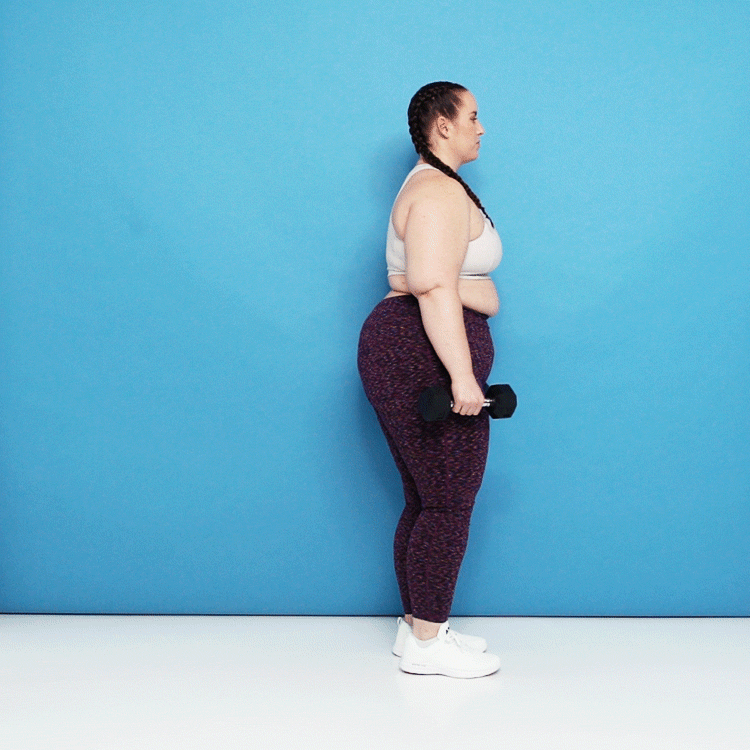
You can do this move with or without weights. Stand with feet shoulder width apart, core engaged.
Step back with your right foot and bend both knees until your left thigh is parallel to the floor to sink into a lunge. Keep your core engaged, hips tucked, and back straight.
Return to starting position by gently pushing off right foot, engaging your left glutes, and stepping forward.
Repeat on the other side. Continue to alternate sides.
Stationary Lunge (Split Squat)
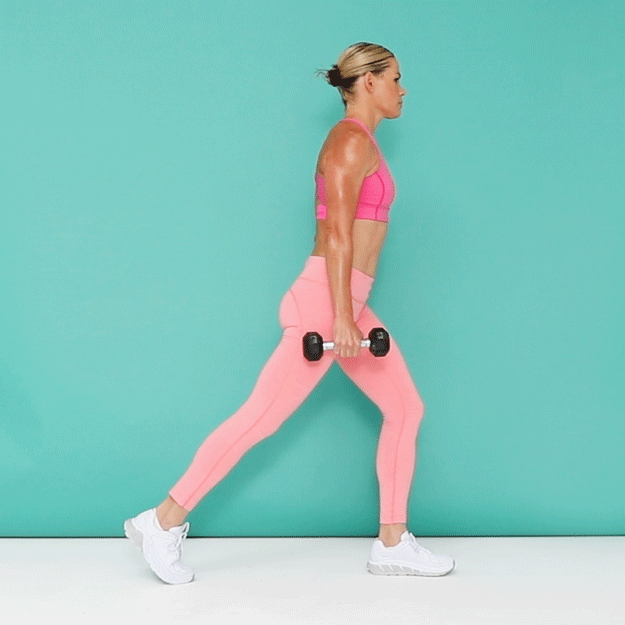
stationary lunge - SELF May 2019 Challenge.gif
Alexandra GenovaStand with your feet staggered, right foot in front, left foot behind you, with both legs straight. Make sure your feet are not directly in front of each other. Engage your core and keep your hips tucked under (avoid arching your low back).
Bend both knees to 90 degrees and sink into a lunge (your right thigh should be roughly parallel to the floor).
Straighten both knees to return to starting position. Repeat on the same side, keeping feet in a stationary position for a set amount of time or reps. Then switch the foot that’s in front, and repeat on the other side.
Make it harder: Add weight, by holding a dumbbell in each hand. You can also make this move more challenging by add a jump at the top of each rep. Spring up, then land lightly on your toes as you immediately sink into a lunge.
Kneel-to-Stand Lunge
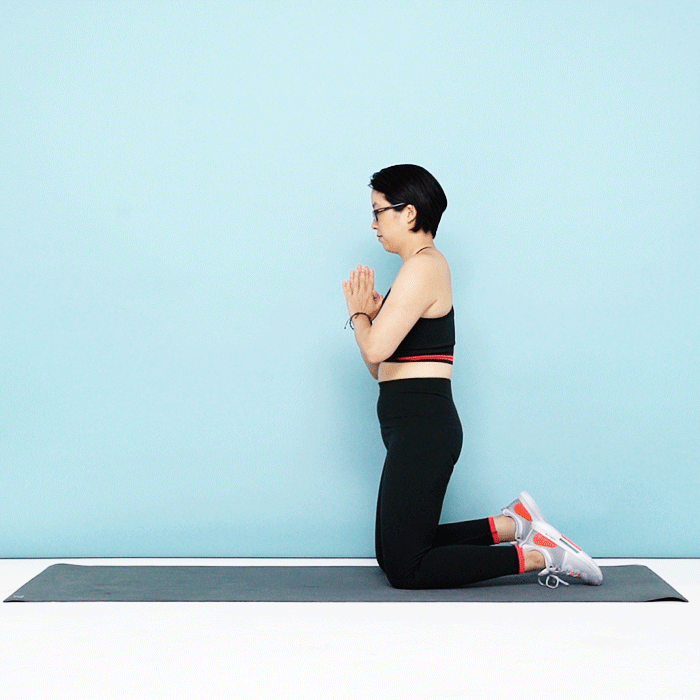
kneel to stand lunge
Katie ThompsonStand with feet hip-width apart, core engaged, and hands on hips or in prayer at chest height.
Step back with you right foot and drop into a reverse lunge, bending both knees to 90 degrees and allowing your right knee to rest on the floor, so you’re on bended knee.
Now step the left foot back to meet the right so you are kneeling on both knees on the floor. Use your core to stabilize, and try to keep your hands on hips throughout.
Step forward with the right foot first so you are kneeling on one knee again. Rise into a lunge, and step left foot to meet right to come into a low squat.
If you can, avoid standing up all the way again. Instead, stay in the low squat and immediately step back with your left foot for the next rep. Continue to alternate sides each time.
Lateral Lunge
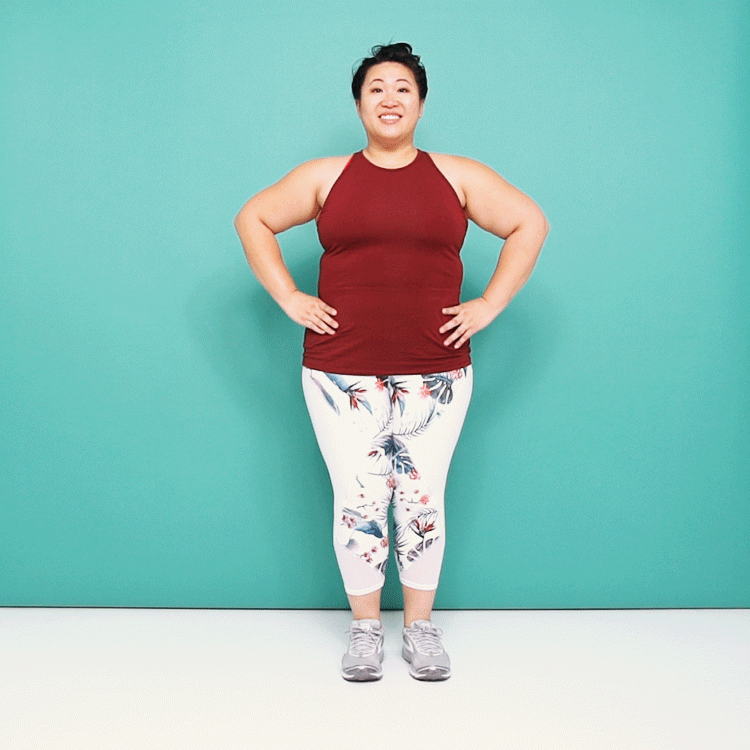
Stand with your feet together, hips tucked, and core engaged.
Take a big step out to the right with your right foot. When your foot hits the ground, hinge forward at the hips, push your butt back, and bend your right knee to lower into a lunge. Your left leg should remain straight.
Pause for a second, sinking to the lowest point of your lunge, then push off your right foot to return to your starting position.
Repeat all reps on the same side, or alternate sides by stepping out with the left foot.
Jumping Lunge (Plyo Lunge)
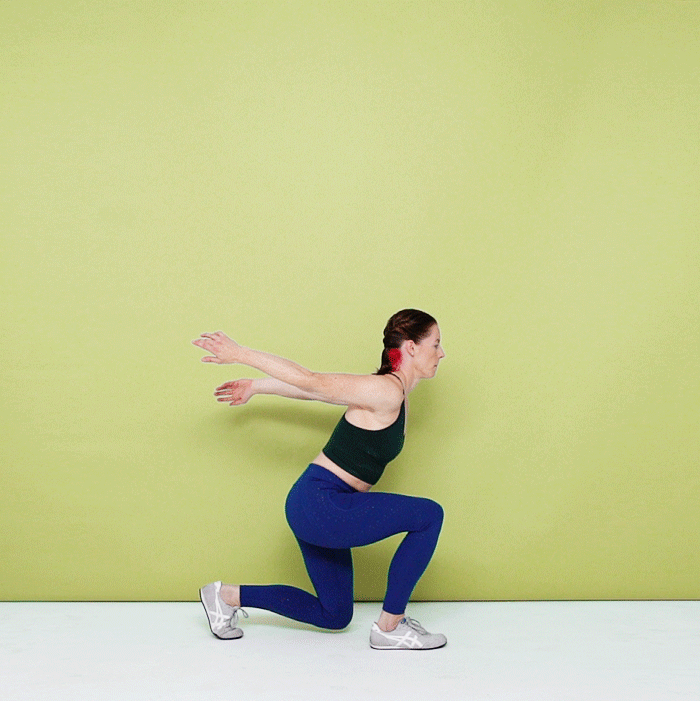
Plyo Lunge - Mia Lazarewicz
Katie ThompsonThis is an advanced plyometric (jumping) exercise and should be avoided if you have knee pain or are just starting out with a new exercise routine.
Begin standing with your feet staggered, right foot in front of left foot, with feet hip-width distance apart. (Your feet should not be directly in front of one another, think railroad tracks, not tight rope.)
Bend both knees to sink into a lunge.
Swinging your arms to help with momentum, spring up, switching the position of your feet midair, so you land with your left foot in front and right foot behind.
Immediately sink into another lunge to cushion your landing.
Continue to jump, alternating which foot lands in front each time.
Common Lunge Mistakes to Avoid
Here are a few common form mistakes people often make when lunging:
Your back leg is basically straight. One of the most common mistakes is that people step too far forward, so their back knee is only loosely bent, instead of bending to 90 degrees. Correct this by taking a smaller step forward.
Your knee extends past your toes. This cue is a bit trickier, since it’s often repeated, but not exactly true. If your form is perfect, you’ve got longer legs, and your knee happens to extend a bit past your toes, that’s probably fine. However, you should be conscious of not leaning your torso too far forward, which will in turn probably mean your knee tips past your toes as well, and place additional (unnecessary) force on your knee and shin.
You don’t use your glutes. Another common mistake (that’s tough to spot!) is using your quads and feet to do all the work—instead of using your glutes. As you sink and stand during each rep, focus on squeezing your glutes to ensure they’re doing the work, and that other muscle groups aren’t compensating unnecessarily.
Safety Tips
You should avoid doing lunges if you have a history of knee problems, hip issues, or if you have been instructed by a doctor to avoid doing lunges. When doing lunges, you should always make sure that you’re on a level, sturdy surface.
And as with all exercises, you should not take on too much at once. If you’re new to exercise, consider easing in with bodyweight lunges before adding weight.
Originally Appeared on SELF
